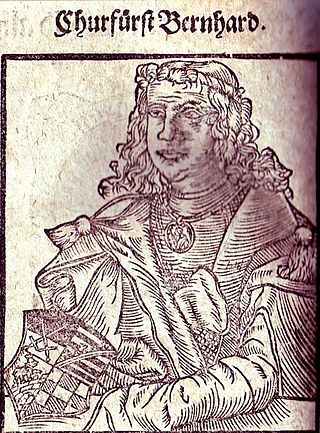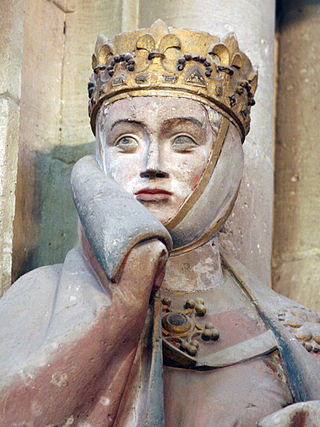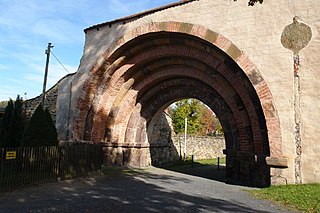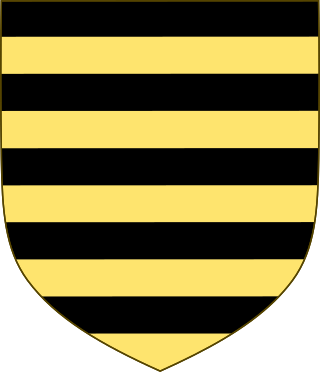
Gernrode is a historic town and former municipality in the Harz District, in Saxony-Anhalt, Germany. Since 1 January 2014, it has been part of Quedlinburg. It was the seat of the former Verwaltungsgemeinschaft of Gernrode/Harz.

Ballenstedt is a town in the Harz district, in the German state of Saxony-Anhalt.

Alexisbad is a small spa town, part of Harzgerode in the district of Harz, Saxony-Anhalt, Germany.

Gernrode Abbey was a house of secular canonesses (Frauenstift) in Gernrode in what is now Saxony-Anhalt, Germany. Gernrode was founded in 959 and was disestablished in the seventeenth century. In the Middle Ages the abbey was an Imperial abbey, which had the status of imperial immediacy, and an Imperial State. In the early modern period, the abbey was part of the Upper Saxon Circle.

Bernhard, a member of the House of Ascania, was Count of Anhalt and Ballenstedt, and Lord of Bernburg through his paternal inheritance. From 1180 he was also Duke of Saxony.
Matilda, also known as Mathilda and Mathilde, was a German regent, and the first Princess-Abbess of Quedlinburg. She served as regent of Germany for her brother during his absence in 967, and as regent during the minority of her nephew from 984.

Anhalt Castle is a ruined medieval fortification near the town of Harzgerode in Saxony-Anhalt, Germany.
Esico of Ballenstedt is the progenitor of the House of Ascania,. Esico was the count of Ballenstedt, and his possessions became the nucleus of the later Principality of Anhalt.

Hedwig of Brandenburg, also called Hedwig of Ballenstedt, a member of the House of Ascania, was Margravine of Meissen from 1156 until 1190 by her marriage with Margrave Otto II.

Uta von Ballenstedt, a member of the House of Ascania, was Margravine of Meissen from 1038 until 1046, by marriage to Margrave Eckard II. She is also called Uta of Naumburg as the subject of a famous donor portrait by the Naumburg Master.

Altzella Abbey, also Altzelle Abbey, is a former Cistercian monastery near Nossen in Saxony, Germany. The former abbey contains the tombs of the Wettin margraves of Meissen from 1190 to 1381.

John II, Margrave of Brandenburg-Stendal was co-ruler of Brandenburg with his brother Otto "with the arrow" from 1266 until his death. He also used the title Lord of Krossen, after a town in the Neumark.

Otto III. Weimar-Orlamünde, sometimes called Otto IV was a German nobleman. He was a member of the House of Ascania and a titular Count of Weimar-Orlamünde. He was the ruling Count of Weimar and Lord of Rudolstadt and Plassenburg.
Himmelpforten Convent was founded as a monastery of nuns following the Cistercian Rule during the 13th century in Himmelpforten, in today's Lower Saxony, Germany. During the 16th century, it was converted into use as a Lutheran Damsels' Convent. The Himmelpforten Convent was founded before 1255 and finally dissolved in 1647. The convent complex was built between 1300 and 1330. After 1645 the buildings, including the abbey, increasingly decayed, until they were little by little demolished. The dilapidated abbey was demolished in 1737 and replaced by today's St. Mary's Church which partially covers the foundations of the former abbey.

Buch Abbey, in German Kloster Buch, is a former Cistercian monastery near Leisnig in Saxony.

Sophia of Saxony was a member of the House of Ascania, and the abbess of Gernrode (r.1220–1244).

Oda of Meinersen was the abbess of Gernrode (r.1248-1260).

Siegfried I of Ballenstedt, was the son of Adalbert II of Ballenstedt, and a member of the House of Ascania. He was count palatine of the Rhineland (r.1095/7-1113), and count of Weimar-Orlamünde (r.1112-1113).
Adalbert von Ballenstedtc. 970,, was Count of Ballenstedt, Vogt of the Nienburg Abbey, and the provost of Hagenrode. He is the earliest known ancestor of the House of Ascania.















